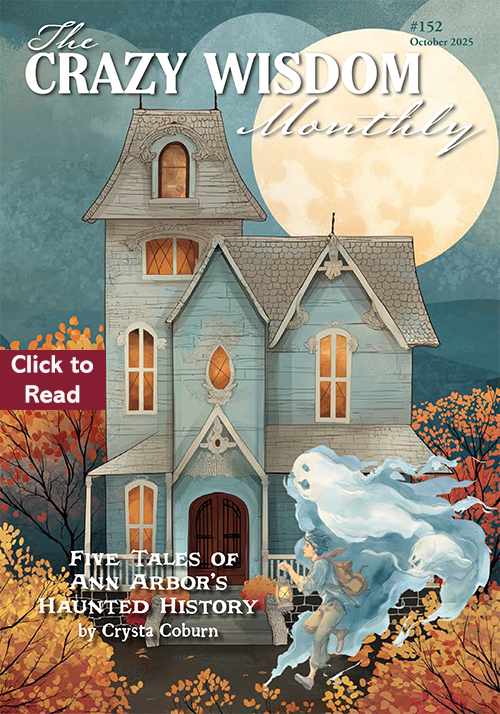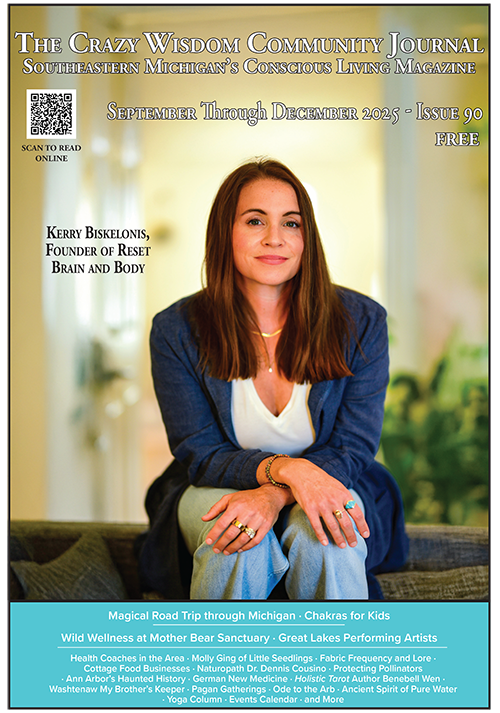By Cashmere Morley
At age five, Paula Hampton knew that there was something magical about art. The way her mother would hold a pencil to paper and make a face appear on a blank canvas, unaided by anything save her imagination, blossomed a world of possibility in Hampton’s heart.
It also sparked a question: Could she do that, too? Conjure something out of nothing?
Like the pencil to canvas, Hampton’s life unfolded before her into several avenues: figure artist, portraitist, and AT&T phone operator, to name a few. Today, she prefers the title “wand maker.”
An Ypsilanti native her entire life, Hampton cut her artistic teeth working alongside figure artist John Lockhart, at Washtenaw Community College. Under his tutelage, she gained a profound understanding of the human body, a skill that would later help her unfurl forms in felled wood when wand making became her profession.
“You don’t just draw,” said Hampton, “...You study the human form. You study anatomy, just like if you’re going to school to become a physician. I had to learn all the human bones in order to understand structure. And how, when a human form moves this way, then the light changes across it that way. I had to translate that on the paper to shadow and form so it became a work of art.”
Translating the three-dimensional onto a two-dimensional piece became her early living. In the 80’s, living in Depot Town, Hampton did not have to go far to find work. Literally outside of her apartment door, Depot Town landlords helped establish the Heritage Festival, where Hampton was asked to be a resident artist. Her studio was situated in one of the old AirTrain railroad cars, where Hampton would sketch portraits alongside of her friend, another resident artist, who was working as a basket weaver.
Through her time as a portrait and figure artist, Hampton would often ask friends to sit for her. A pair of these friends—a couple of local pagans, who lived on a farm on the outskirts of town—invited Hampton over one afternoon where the couple were working on crafting a wand out of fallen wood.
“He had cut the wood for his wife, though she had chosen the wood herself because she had an interest in making her own wand. Watching them work—I was instantly curious. I immediately wanted to try making my own [wand].”
Hampton had found the incorporation of wood in her artwork intriguing since she was a child. She would paint on the backs of found wooden objects, such as the back of a mirror, then incorporate those two-dimensional paintings into a table or an item that was more three-dimensional in finality. She was always, conceptually or physically, working between the two worlds.
“It was a combination of watching her make her own wand and seeing what her husband could do with carving and the textural elements of the wood that got me curious. Even when he wasn’t at work, Ken would still always have something in his hands that he was working on. And I used to just watch him carve on pieces sometimes,” said Hampton.
It was not until the Harry Potter craze during the early 2000’s, when wand woodworking would levitate its way into Hampton’s creative brain once more. After attending a Halloween party dressed as a Hogwart’s character, Hampton put her artistic talents back to work, crafting a wizard wand for her costume. Soon, her nephews took notice of the special piece, and it wasn’t long before Hampton had family members calling upon her for a wand of their own.
“That’s when I knew I had something really special here,” said Hampton.
Coincidentally, Hampton’s career at AT&T was coming to a close around the same time. A new door was opening up, and, as if by a flick of a wand, the energy in Hampton’s life was unexpectedly moving.
Thus began Hampton’s exploration in taking her wands wholesale to metaphysical stores and events such as Artes & Crafts in Hartford, and ConVocation in Dearborn. Hampton sold her handmade, one-of-a-kind wands from around 2004 up until 2017 through these outlets until she decided she wanted to scale back, get off the road, and sell more locally. Currently, Hampton is selling wands at Evenstar’s Chalice in Ypsilanti.
“If you are wanting to, in any way, shape, or form, move energy in your life, a wand is a powerful tool for that intention,” said Hampton. “Many pagans and energy workers use my wands for this purpose. But kids love them, too, and parents love to buy my wands for the purpose of gift giving as well.”
Read related article: Plant Medicine and Magic
For Hampton, the wand making process begins when Mother Nature decides.
“I do not purchase wood,” said Hampton. “All my wands are made entirely by hand, without the use of electric tools, except for a wood burner which I use to etch designs into the wands.”
This means that when a storm hits, Hampton is searching the woods of Ypsilanti and the surrounding area for felled wood such as birch, ash, and willow--whatever Mother Nature has in store. Or, Hampton sources wood from friends. Every branch she finds, Hampton takes to her barn to dry out in barrels. The wands stay that way for at least a year before she begins to work on them. This way, the moisture is out of the wood completely, and any splits or cracks in the bark are evident.
Hampton works in cycles of the moon. Beginning a new batch of wands happens in the waning cycle, “because the wood is dead. The way I see it, it’s being resurrected into its next life as a working tool. During the waning phase, I’m cleaning off the cambium of the bark, [the part of the bark responsible for root and stem growth] and I sand the wands to get them nice and smooth.”
When Hampton’s father passed, he left her boxes of amethyst and crystal tips, souvenirs of his “amateur rockhound days” sleuthing around the Upper Peninsula for gemstones. The incorporation of gemstones into her wooden wands felt like kismet to Hampton.
“Dad had seven kids. He worked full-time for Ford Motors, but he loved being around us when he was home. He would go out to quarries pretty frequently. There was always that week of being off at Ford, the week when there would be a changeover, and he would put all of his kids in the car and we’d go up to Grand Marais looking for Lake Superior agate, or we’d go to Petoskey and search for Petoskey stones... he had all of the jewelry making equipment in the basement: Tumblers. Tools for slicing. I had everything I needed. Almost everything I used [initially for the wands] was from his collection until probably about five or six years after he passed. Then I started going to rock shops. Sourcing materials for the wands ethically has always been important to me.”
Hampton said she’s created between 1,200 – 1,500 wands since she began in 2004. “My wands are playfully healing,” said Hampton. “They allow you to play, but they also help you heal your own inner desires.”
And just like in the Harry Potter series, Hampton reiterated, “...the wand has a way of choosing the person. I’ve held onto wands for years, waiting for the right person to pick them up. Whatever combination of wood and crystals I’ve used, will draw the person best suited to work with that wand.”
During the final selection of a wand, Hampton said the tool should feel like part of the person holding it—like an extension of the limb.
Hampton recalls a time when a young man walked up to her booth. “He must have picked up nearly every wand I had displayed,” she recalled. “I watched the gears turning in his head. He finally settled on two wands both made of white oak, but one had the Celtic infinity sign, where the other had symbols for financial success. I asked, ‘what are you using the wand for?’ he answered, ‘I want to ask a girl to marry me. She’s special to me but I’m not sure I’m special to her.’”
Hampton told the man to choose the wand with infinity knots, because “you are asking for the energy of the infinite universe to work in your favor.”
Months later, in the summertime, the man came back to Hampton’s booth, walking hand-in-hand with a beautiful blonde woman. “I could tell, by the look on his face, that it had worked,” Hampton said. “He came up to me and said, ‘I had to come back and let you know how you worked out in our story.’ The wand gave him that boost of confidence that he needed to ask her the question. Customer satisfaction stories like that are my favorite.”
While Hampton hopes to one day get her hands on some ginkgo wood, or black willow, she is happy to craft her wands out of whatever nature provides.
“I’ve always known that if I ever lose my sense of that five-year-old wonder in myself, that part of myself who gets filled with wonderment and curiosity, that sense of wanting to observe and learn something more, that’s when I’ve got one foot in the grave. That’s what keeps me motivated, creatively. That’s what keeps my spirit alive.”




































































































































































































Curtis Wallace introduced his Be Creative Studio LLC in Ypsilanti, Michigan in 2019 after a lifetime of sharing his art professionally and prolifically. Be Creative Studios honors the honeybee and hexagons in their logo.